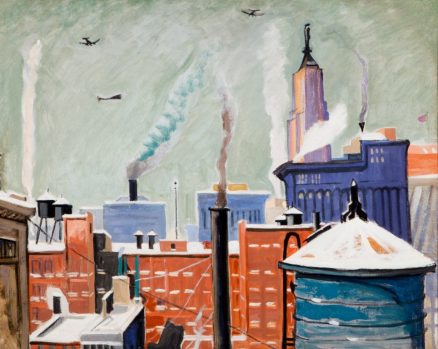Untitled (Looking West from the Fine Arts Building)
, circa 1933Oil on canvas, 25½ by 32 inches
- Zoom in on Artwork
- Print Page
- Email Page to Friend
An urban vista of rooftops, chimneys, utility lines, and water tanks under a thin layer of snow forms the subject of Jean Crawford Adams’s untitled painting. The view looks westward from a window in Chicago’s Fine Arts Building on Michigan Avenue, long a site of many artists’ studios. The tallest structure, in the right distance, is the Art Deco–style Chicago Board of Trade building of 1930, a forty-four-story skyscraper topped by John Storrs’s statue of Ceres, goddess of grain. Seen from the unconventional perspective of Adams’s composition, the eccentrically tinted buildings, with their varied heights and configurations, appear as arbitrary outcroppings in a manmade “forest” that mimics a natural landscape. Playing off the static, faceless structures are thin plumes of steam and smoke rising into the chill air. Where flying birds might enliven a traditional landscape scene, distant airplanes cross the overcast sky, at upper left.
Primarily a landscapist, Adams typically portrayed more obviously picturesque settings in rural France, the American Southwest and rural Midwest, and Provincetown, Massachusetts. As early as 1922, she exhibited paintings of the urban Chicago River, however, and in the early 1930s she made several rooftop city views. Included among the paintings in her solo show at the Art Institute of Chicago in 1930 was Roofs in Loop. In the Art Institute’s 1935 “Chicago and Vicinity” show, Adams was represented by two more such works: View from the Auditorium (undated; Chicago History Museum) and Roofs—the latter possibly identical with this painting.
Early in the era of the skyscraper, artists began picturing cities such as New York and Chicago from a bird’s-eye perspective. In Chicago, modernist artists in particular took notice of overlooked urban spaces or presented the city from unusual viewpoints. In Adams’s image, the strangely uninhabited world of the urban rooftop is both mysterious and lyrical, the accidental result of purely functional considerations—in striking contrast to the decorous public face of the city as experienced at street level.
Wendy Greenhouse, PhD
